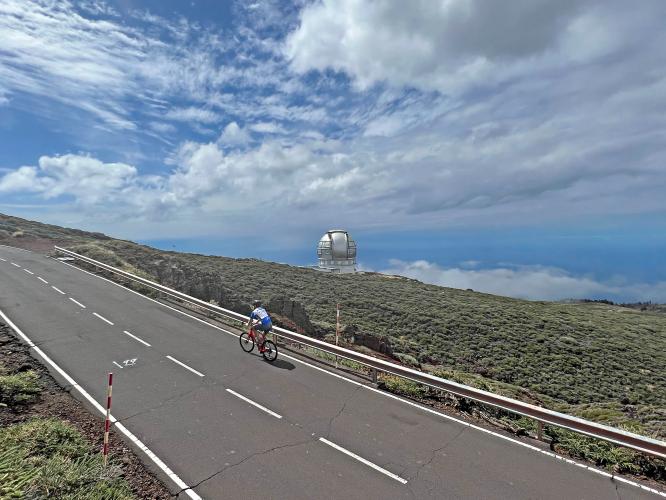![]()
Cycling Roque de los Muchachos East
Ride 41 kilometers gaining 2,473 meters at 5.6% average grade (7.7% climb only)
This climb begins in Santa Cruza de la Palma on the Canary Island of La Palma. Roque de Los Muchacho means “Rock of the Boys” and is a rocky mound at the highest point on the Island of La Palma. Also at the top of this climb are several observatories, with some of the largest telescopes in the world, constructed there because the altitude and dry climate provide for excellent observing conditions.
![]()
Ranked #84 world and #8 in Spain.
There are 3 segments to this climb:
- The first 32 kilometers averages 6.8%;
![]()
The first steep climb is followed by a 5.3 kilometer 2.4% descent (dropping 165 meters)
- At the bottom of the descent, turn left onto Roque de los Muchachos Road for the final 3.5 kilometers at 7.3% average grade.
![]()
3.9 kilometers at 7.3%
Learn about the Roque de los Muchachos telescopes at Instituto de Astroffisica de Canarias.
![]()
3 MAGIC telescopes - detect high energy gamma rays -
![]()
THE FINISH AND TOP OF THE VOLCANO:
![]()
Climb finishes above the observatories - there are 2 fairly short hikes to viewpoints from the top.
![]()
The world’s largest telescope - Gran Telescopio Canarias - 10.4 meters (34.1’)
“Gran Telescopio Canarias (GTC), the largest optical telescope in the world, with a mirror that has a diameter of 10.4 metres (34.1 feet). It is located at the Roque de los Muchachos Observatory on La Palma (2,326 metres [7,631 feet]) in the Canary Islands of Spain. The mirror consists of 36 hexagonal pieces, which can be moved separately from each other, and the shape of each piece can be changed. These two types of movements can compensate for the changes in the observed light that are caused by turbulence in Earth’s atmosphere. The telescope is mounted in a system that moves both in altitude and in azimuth to observe any point in the sky. Construction of the GTC began in 2000; it made its first observation in 2007. The GTC is operated by a consortium of four institutions: the Institute of Astrophysics of the Canary Islands, the National Autonomous University of Mexico, the National Institute of Astrophysics, Optics, and Electronics of Mexico, and the University of Florida.” Britannica.com
![]()
Second best location for observatories in Northern Hemisphere behind Mauna Kea
Established in 1985, there are roughly 16 observatories at the top of Roque de los Muchachos from countries including Spain, Britain, The Netherlands and other countries.
![]()
Many of the observatories are near the steep cliffs of the Roque de las Muchachos volcano.
DangerousRoads.org writes of this magnificent climb:
“Roque de los Muchachos is a high mountain pass at an elevation of 2.423 m (7,949 ft) above the sea level, located on the island of La Palma in the Canary Islands, Spain. It’s one of the highest mountain passes of Spain.
The road to the summit is called Carretera al Roque de los Muchachos. Fog, clouds and snow make the road dangerous. The road is 3.8km long starting in the LP-4 road. It’s asphalted and was built for access to the telescopes of an astronomical observatory near the summit. The road is really steep, with sections up to 12.0%.This immense climb is one of the best places in the world for stargazing. It is a drive-to summit, with a developed asphalt road right to the top, a parking lot right on the summit and an information booth right there. The drive is definitely worth it. There are many excellent photo opportunities. Don't forget your camera with lots of film/memory and fully charged batteries! The Roque de los Muchachos boasts one of the clearest skies on the planet thanks to the climatic conditions and its unique physical characteristics.” DangerousRoads.org

 We've partnered with Sherpa-Map.com to bring you the best route planning tool. With a PRO Membership you can use this climb as a reference when creating your route.
We've partnered with Sherpa-Map.com to bring you the best route planning tool. With a PRO Membership you can use this climb as a reference when creating your route. 

